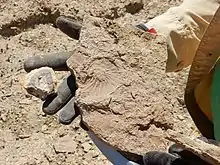| Juana Lopez Member | |
|---|---|
| Stratigraphic range: | |
 Juana Lopez Member near its reference section south of Cuba, New Mexico | |
| Type | Member |
| Unit of | Mancos Shale (San Juan basin) Carlile Formation (Denver and Raton Basins) Benton Shale (North Park Basin) |
| Underlies | Niobrara Formation |
| Overlies | Codel Sandstone member of the Carlile |
| Thickness | 140 feet (43 m) |
| Lithology | |
| Primary | Sandstone with abundant carbonate fossil grains |
| Other | Gravel, Codel fragments |
| Location | |
| Coordinates | 35°29′12″N 106°12′04″W / 35.4866°N 106.2010°W |
| Country | |
| Type section | |
| Named for | Mesita Juana Lopez Grant, six miles northwest of Los Cerrillos, New Mexico |
| Named by | Rankin |
| Year defined | 1944 |
 Juana Lopez Member (the United States)  Juana Lopez Member (New Mexico) | |
Juana Lopez refers to both the uppermost member of the Carlile Shale formation and to the environment that caused it to form. The Juana Lopez Member is calcareous sandstone dated to the Turonian age of the Upper Cretaceous and is exposed in the southern and western Colorado, northern and central New Mexico,[1] and northeastern Utah.[2] The unit has been described as "the most enigmatic" member of the Carlile Shale.[3]
Description
The Juana Lopez Member consists of beds of calcarenite separated by intervals of mudstone. Calcarenite is a form of limestone composed mostly of sand-sized carbonate grains. In the Juana Lopez Member, these are mostly fragmented coral, shells (especially inoceramid prisms), shark teeth, bone, and other fragmented fossils.[4] The Juana Lopez Member smells of sulfur when freshly broken. It formed on wide, shallow marine shelf, with strong wave action, but with little sediment coming in from land. It was exposed on the land surface between the retreat of the Greenhorn cycle and the advance of the Niobrara cycle of the Western Interior Seaway.[1]
As originally defined, the unit included only the uppermost calcarenite bed, with a thickness of less than 10 feet (3.0 m). As currently defined, the unit includes the entire sequence of calcarenite beds separated by mudstone intervals, and is up to about 140 feet (43 m) thick.[5]
The unit is one of the most extensive units of the Western Interior Seaway, being present in the Mancos Shale of the San Juan Basin, the Carlile Shale of the Denver Basin and Raton Basin, and the Benton Shale of the North Park Basin.[6] Outcrops have been found as far east as Kansas and as far south as west Texas.[7]
Fossils

The unit is highly fossiliferous. Fossils identified in the unit are primarily marine molluscs, including Prinocyclus, Inoceramus,[8] Ostrea,[9] Lopha lugubris, Coilopoceras, Hourcquia, and Scaphites. The fossils indicate that the member is upper Turonian in age.[10] Teeth of the shark Ptychodus are also found.[9]
History of investigation
The distinctive beds and fossils of the member were first noted by John Strong Newberry in 1861.[11] The member was first designated in 1944 by C.H. Rankin, Jr., who recognized the member throughout northern New Mexico and western Colorado. Rankin established the correlation between the Mancos Shale and the Colorado Group and was able to identify most of the units of the Colorado Group within the Mancos Shale, and identified the top of the Juana Lopez Member as the top of the Carlile Shale.[8] In 1955, Dan Bozanic revised the definition of the member to include a much larger set of beds,[12] and this revision has been widely accepted.[13]
References
- 1 2 Lewis, Russell K. (2013), Stratigraphy and depositional environments of the Late Cretaceous (Late Turonian) Codell sandstone and Juana Lopez members of the Carlile shale, southeast Colorado, Mines Theses & Dissertations, retrieved 2018-08-14
- ↑ Molenaar, C.M.; Cobban, W.A. (1991). "Middle Cretaceous stratigraphy on the south and east sides of the Uinta Basin, northeastern Utah and northwestern Colorado". United States Geological Survey Bulletin. 1787-P. doi:10.3133/b1787P.
- ↑ Lewis 2013.
- ↑ Hook, Stephen C.; Cobban, William A. (August 2013). "The Upper Cretaceous (Turonian) Juana Lopez Beds of the D-Cross Tongue of the Mancos Shale in central New Mexico and their relationship to the Juana Lopez Member of the Mancos Shale in the San Juan Basin" (PDF). New Mexico Geology. 35 (3): 59–81. Retrieved 14 September 2021.
- ↑ Hook & Cobban 2013, pp. 59–61.
- ↑ Hook, Stephen C.; Cobban, William A. (1980). "Reinterpretation of type section of Juana Lopez Member of Mancos Shale" (PDF). New Mexico Geology. 2 (2): 17. Retrieved 14 September 2021.
- ↑ Hook & Cobban 2013, p. 61.
- 1 2 Rankin, C.H. Jr. (1944). "Stratigraphy of the Colorado group, Upper Cretaceous, in northern New Mexico". New Mexico Bureau of Mines and Mineral Resources Bulletin. 20. Retrieved 14 September 2021.
- 1 2 Ekren, E.B.; Houser, F.N. (1965). "Geology and petrology of the Ute Mountains area, Colorado". United States Geological Survey Professional Paper. Professional Paper. 481. doi:10.3133/pp481.
- ↑ Hook & Cobban 1980, p. 19.
- ↑ Hook & Cobban 2013, p. 60.
- ↑ Bozanic, Dan (1955). "A brief discussion on the subsurface Cretaceous rocks of the San Juan Basin". Four Corners Geological Society Guidebook. 1: 89–107.
- ↑ Hook & Cobban 1980, pp. 19–20.